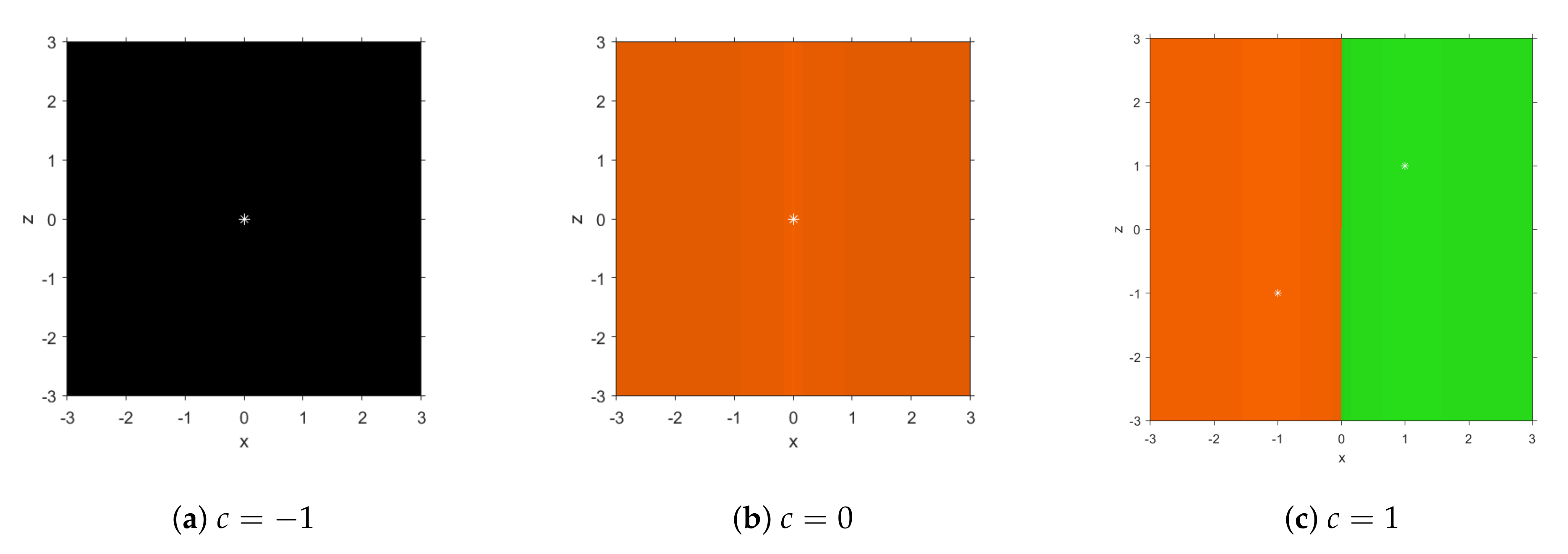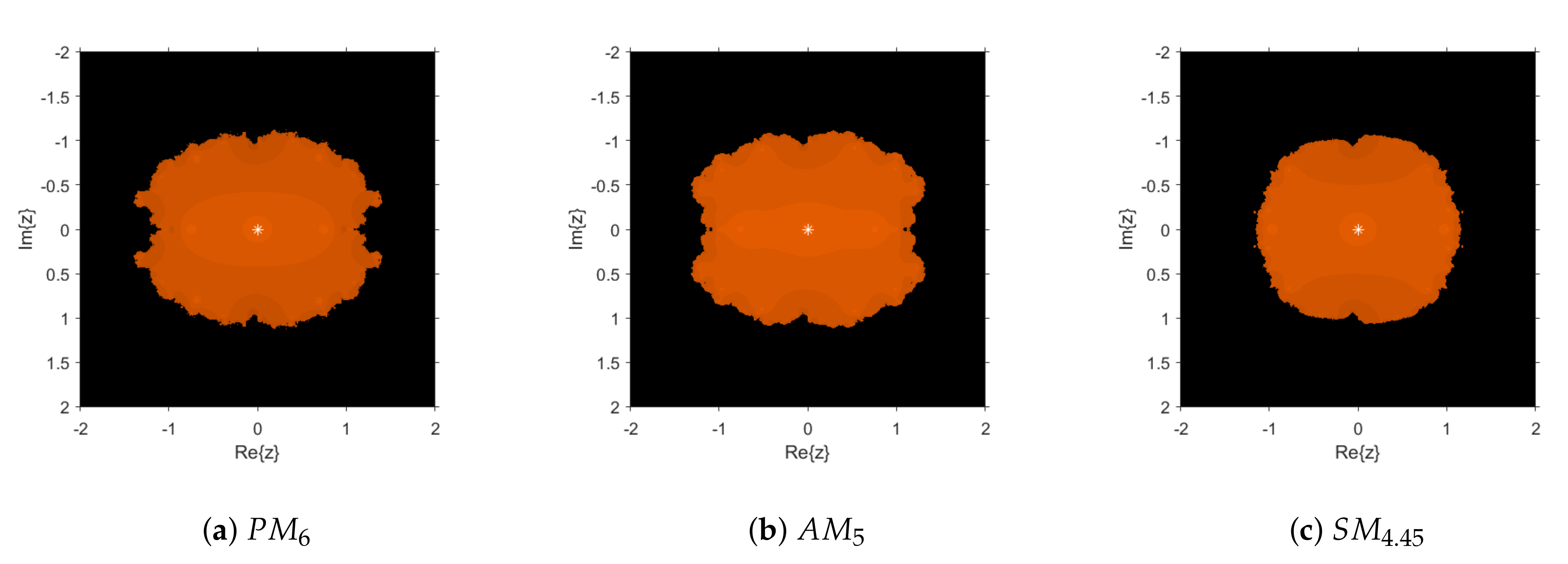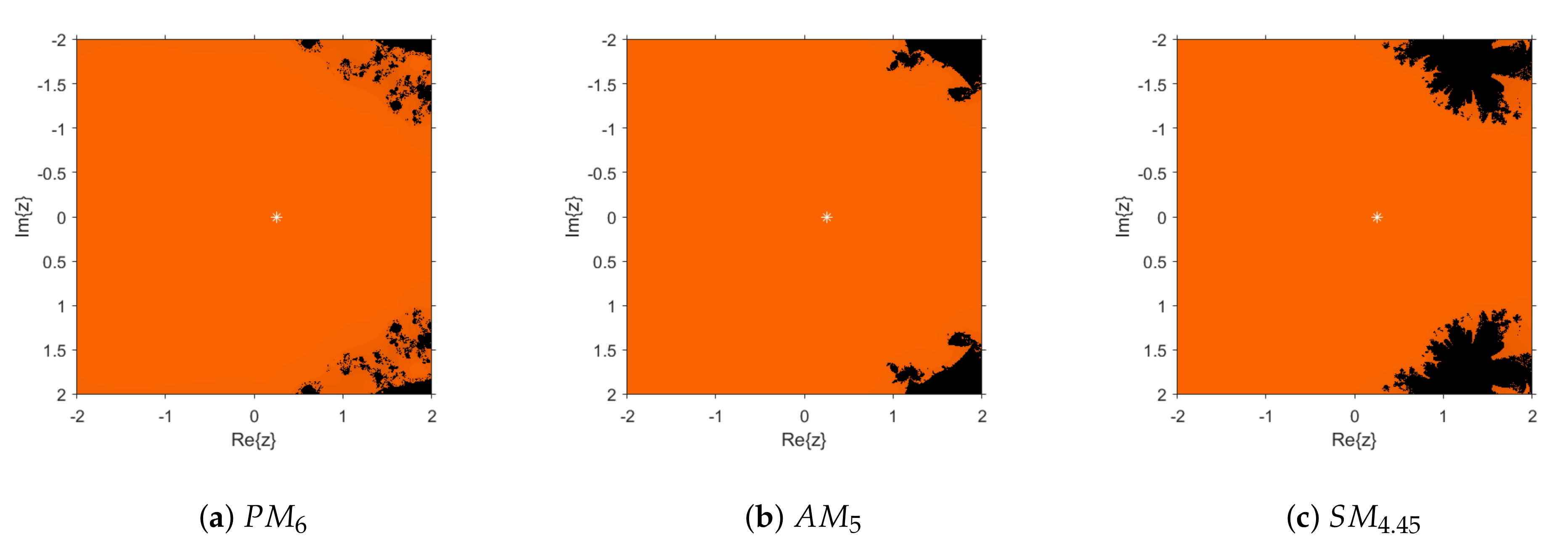1. Introduction
New and efficient iterative techniques are needed for obtaining the solution
of a system of nonlinear equations of the form
where
,
being an open convex set, which is present in scientific, engineering and various other models (details can be found in the articles [
1,
2,
3,
4,
5]).
The search for the solution
of the system
is a much more complex problem than finding a solution of a scalar equation
. As in the scalar case, we can transform the original system into an equivalent system of the form:
for a given vector function
, whose coordinate functions we will denote by
and
. Starting from an initial approximation
, we can generate a succession of vectors of
by means of the iterative formula
where
.
We say that the process is convergent if
when
; then,
will be, under certain conditions of the function
G, a solution of the system
. The vector
is called a fixed point of the function
G and the algorithm described by the Equation (
2) is a fixed point method.
A very important concept of iterative methods is their order of convergence, which provides a measure of the speed of convergence. Let be a succession of vectors of such that they tend to the solution of the nonlinear system when j tends to infinity. The convergence of this sequence is said to be
- (i)
linear, if there exist M, and such that for all .
- (ii)
of order p, if there exist and such that for all .
This definition is independent of the norm of used.
We denote by the error in the j-th iteration and call an error equation to the expression , where L is a a p-linear function , and p is the order of convergence of the method.
The most known fixed-point iterative method is Newton’s scheme:
where
denotes the Jacobian matrix of operator
F. However, there are many practical situations where the calculations of a Jacobian matrix are computationally expensive, and/or it requires a great deal of time for them to be given or calculated. Therefore, derivative-free methods are quite popular for finding the roots of nonlinear equations and systems of nonlinear equations.
The first multidimensional derivative-free method was proposed by Samanskii in [
6], by replacing the Jacobian matrix
with the divided difference operator:
This scheme keeps the quadratic order of convergence of Newton’s procedure. It is the vectorial extension of scalar Steffensen’s method.
Later on, Traub defined a class of iterative methods (known as Traub-Steffensen’s family) [
7], given by
where
. The class (
3) can be easily recovered from Newton’s well-known method [
7] by replacing the Jacobian matrix with operator
. Let us remark that, for the particular value of
in expression (
3), the deduced scheme is Samanskii’s one.
In recent years, different scalar iterative schemes with memory have been designed (a good overview can be found in [
8]), mostly derivative-free ones. These have been constructed with increasing orders of convergence, and therefore, with increasing computational complexity. In terms of stability, some researchers compared the amplitude of the set of initial points converging to the same attractor, using complex discrete dynamics techniques. In [
9], the authors observed that iterative schemes with seventh-order memory convergence showed better stability properties than many eighth-order optimal procedures without memory. This graphical comparison was subsequently used by different authors; see, for example, the work of Wang et al. in [
10] and Cordero et al. [
11] in 2016 or the investigations of Bakhtiari et al. [
12] in 2016 and Howk et al. [
13] in the following years.
Regarding nonlinear vectorial problems, some methods with memory have been developed which improve the convergence rate of Steffensen’s method or Steffensen-type methods at the expense of additional evaluations of vector functions, divided difference or changes in the points of iterations. In past and recent years, a few high-order multi-point extensions of Steffensen’s method or Steffensen-type methods have been proposed and analyzed in the available literature [
14,
15,
16,
17] for solving nonlinear systems of equations. All these modifications are in the direction of increasing the local order of convergence with the view of increasing their efficiency indices, as they usually do not involve new functional evaluations. Therefore, these constructions occasionally possess a better order of convergence and efficiency index, but there are very few iterative schemes of this kind in the literature, due in part to their recent development and also due to the difficulty of design and convergence analysis.
In 2020, Chicharro et al. [
18] proposed such an extension, which is given by
and its higher-order version is
The versions have third and fifth order of convergence, respectively. An extension of this type was first reported by Chicharro et al. [
18] based on Kurchatov’s divided difference operator.
The authors developed in [
19] a technique that, using multidimensional real discrete dynamics tools, is able to analyze the stability of iterative schemes with memory, not only in graphical terms, but essentially in analytical terms. Using this technique, the stability of the fixed and critical points of secant, Steffensen’ and Kurchatov’s methods (among others) were studied in [
19]. It was also used to analyze other procedures, such as those described in [
20], the one defined by Choubey et al. in [
21] and those by Chicharro et al. in [
22,
23,
24].
The aim of this work was to produce two new schemes without and with memory of orders four and six, respectively. Our scheme is also based on Kurchatov’s divided difference operator. However, our scheme does not have only higher-order convergence, unlike the recent scheme (
5). However, we did not use any additional functional evaluation of
F or
(Jacobian matrix of
F) or another iterative substep. We also provide a deep analysis of the suggested scheme regarding the order of convergence (
Section 2) and its stability properties, constructing an associated multidimensional discrete dynamical system. Therefore, the good performance in terms of convergence to the searched roots and wideness of their basins of attraction is proven, as on polynomial functions as on non-polynomial ones, in
Section 3. In addition, we compare in
Section 4 our methods to the existing recent methods on several numerical problems with similar iterative structures. On the basis of the results, we found that our methods perform better than the existing ones when dealing with residual errors, the difference between two consecutive iterations and stable computational order of convergence. Finally, some conclusions and the references used bring this manuscript to an end.
4. A Qualitative Study of Iterative Methods with Memory: New and Known
In this section, we analyze the stability of the proposed scheme with memory in its scalar form, as this kind of study yields multidimensional operators to be analyzed and it does not support the use of vectorial schemes. However, its performance on systems of nonlinear equations is checked in
Section 5 and it is compared with other known schemes with memory.
The expression of a scalar fixed-point iterative method with memory, using two previous iterations to calculate the following estimation, is
and
being the starting estimations. We use the technique presented in [
19,
20] to describe any method with memory as a discrete real vectorial dynamical system, in order to analyze its qualitative behavior.
In order to calculate the fixed points of an iterative method with iteration function
, an auxiliary fixed point multidimensional function
can be defined, related to
by means of:
and being, again, the initial estimations. Therefore, a fixed point of this operator will be obtained when not only , but also .
From function
, a discrete dynamical system in
can be defined by
, where
is the operator of the iterative method with memory. The fixed points
of
satisfy
and
. This notation implies
and
. In the following, we recall some basic dynamical concepts that are direct extensions of those used in complex discrete dynamics analysis (see [
26]).
Let us consider the vectorial rational function , usually obtained by applying an iterative method on a scalar polynomial . Then, if a fixed point of operator is different from , where r is a zero of , it is called a strange fixed point. On the other hand, the orbit of a point is defined as the set of successive images from by the vector function—that is, . Indeed, a point is called k-periodic if and , for .
The qualitative performance of a point of
is classified depending on its asymptotic behavior. Thus, the stability of fixed points for vectorial operators satisfies the statements appearing in the following result (see, for instance, [
27]).
Theorem 3. Let Γ from to be of class . Assume is a k-periodic point. Let be the eigenvalues of the Jacobian matrix . Then, it holds that
- (a)
If all the eigenvalues verify , then is attracting.
- (b)
If one eigenvalue verifies , then is unstable—that is, repelling or saddle.
- (c)
If all the eigenvalues verify , then is repelling.
Moreover, a fixed point is said to be not hyperbolic if all the eigenvalues of satisfy . Specifically, if there exist an eigenvalue satisfying and another one such that , then it is called saddle point.
There is a key difference between the study of the stability of a fixed point in scalar and vectorial dynamics: In the first case, if then is attracting; in particular it is superattracting if and it is repelling when , being the scalar rational function related to the iterative scheme on a low-degee polynomial ). In the vectorial case, the character of the fixed points is calculated by means of the eigenvalues of the Jacobian matrix (see Theorem 3). Nevertheless, sometimes the Jacobian is not well-defined at the fixed points. In these cases, we impose on the rational operator G the condition , so that it is reduced to a real-valued function. Therefore, the stability of the fixed point can be inferred from the absolute value of its first derivative at the fixed point.
By considering
an attracting fixed point of function
, we define its basin of attraction
as the set of preimages of any order:
A key element in the stability analysis of an iterative method is the set of critical points of its associated rational function
: if
satisfies
,
x is called a critical point. A critical point
such that
c is not a root of
is called a free critical point. Another way to get critical points is finding those points that make null the eigenvalues of
. As an extension of the scalar case, if they are ant composed by the roots of polynomial
, they are named free critical points. Indeed, Julia and Fatou [
26] proved that there is at least one critical point associated with each basin of attraction. Therefore, by studying the orbit of the free critical points, all the attracting elements can be found. This result is valid for both complex and real iterative functions.
In this section, we analyze the performance of three different schemes with memory—our proposed scheme (
22) and two known similar schemes, which are defined in (
5), taken from Chicharro et al. [
18]—on quadratic polynomials that we denote by
, which use Kurchatov’s divided difference in order to introduce memory. We also analyze scheme
where
,
and
=
. It was from Petkovic et al. in [
15]. We denote it by
and use it with
.
These schemes have several similarities: they are vectorial schemes with memory; they include divided differences operators in their iterative expressions; they are mainly used to define their respective accelerating parameters. However, we are going to see that the use of these elements does not determine the wideness of the sets of initial estimations converging to the roots, when real multidimensional discrete dynamics tools are used.
In order to extend the results to any quadratic polynomial, the first analysis is shown for on , so that the value of c yields a situation with real, complex or multiple roots depending on , or , respectively. The multidimensional rational function in this particular case will be denoted in what follows by . This analysis can be summarized in the following result.
Theorem 4. The multidimensional rational operator associated with proposed scheme , when it is applied on polynomial ——isand it isfor . Moreover, satisfies: - (a)
There are no strange fixed points.
- (b)
If , there are eight different components of the free critical points, which are defined as , , being the (real) roots of polynomial . If , there are not free critical points.
Proof. Let us remark that operator can be obtained by directly applying method to polynomial . Moreover, we know that fixed points of will have equal components. This is the reason why, when we force the three consecutive iterates to be equal (), then the only fixed points are composed by the roots . That is, and .
Regarding the critical points, the Jacobian matrix
is
with eigenvalues
.
By definition, the components of critical points are those values making null the eigenvalues of . By using the change of variables on the second factor of the numerator of the not null eigenvalue, we get . This polynomial only has real roots for , denoted by , . Then, if , there exist eight different componts of free critical points , . □
A very useful tool to visualize the analytical results is the dynamical plane of the system, composed by the set of the different basins of attraction. It can be drawn by means of the programs presented in [
28], after some changes to adapt them to schemes with memory. The dynamical plane of a method is built by calculating the orbit of a mesh of
starting points
(although
z does not appear in the rational function
) and painting each of them in a different color (orange and green in this case) depending on the attractor they converge to (marked as a white star), with a tolerance of
. Additionally, they appear in black if the orbit has not reached any attracting fixed point in a maximum of 80 iterations. In
Figure 1, we show the dynamical planes of this method for selected values of
c, in order to show its performance.
Let us remark that, as by definition all the fixed points have equal components, they will always appear in the bisector of the first and third quadrants of the dynamical plane. It can be observed that, when there are no real roots (
,
Figure 1a), no other attracting element appears; when
, the only root is multiple and the convergence is linear, so there is global convergence to
, as can be seen in
Figure 1b. In
Figure 1c, the convergence to the roots is also observed to be global, their basins of attraction being two symmetrical half-planes, which is exactly the same behavior as Newton’s method on quadratic polynomials.
Moreover, let us remark that when (real simple roots case), there are not free critical points, as in this case the only possible performance of the method was the convergence to the roots. The reason for this behavior is that in each basin of attraction there must be a critical point; if the only critical points are the roots of that basin, then there is no other possible convergence.
Comparisons with Other Methods with Memory for Nonlinear Problems
Here we compare the stability of the proposed method with that of known and schemes. Firstly, we show their performances on quadratic polynomials: . The dynamical planes are plotted in the complex plane, by starting the iterative methods with memory with an initial value of the accelerating parameter of om each case, for any initial guess , defined in a mesh of points and with a maximum of 80 iterations.
As shown in
Figure 2 and
Figure 3, all three methods have been used to estimate the complex roots of the unity of second and third degrees. It can be observed that the performances with
and
were very similar for quadratic polynomials, showing global convergence, similar to that of Newton’s scheme.
However, this global convergence is held on cubic polynomials in the case of , but in case of , black areas of no convergence to the roots appear. Iterative method shows these black regions both for quadratic and cubic polynomials, which are bigger in the cubic case.
This good performance of the set of converging initial estimations of proposed method
is also shown in the case of non-polynomial equations: let us notice the performances of all known and new methods on the complex rational function
,
with a simple zero at
. The basins of attraction of the root appearing in
Figure 4, being similar, are wider in case of
than for
or
.
Additionally, in
Figure 5 the basin of attraction of
, the simple root of
, is very wide in the case of
, with small areas of no convergence to the root, in comparison with those of known methods
and
.
Thus, it can be concluded that proposed method had very stable performance, as in real and in complex spaces, both for polynomial and non-polynomial functions, in the scalar case. In spite of having the same accelerating parameter as the method, the new scheme has proven to be better than known ones in terms of order of convergence and also in terms of stability. In the next section, its numerical performance on nonlinear systems of different sizes is demonstrated.














